Type Special Operations | ||
 | ||
Active 1944–1948; 1951–1963; 1967–1972; 1988–present Part of Air Force Special Operations Command | ||
The 9th Special Operations Squadron is part of the 27th Special Operations Wing (27 SOW) at Cannon Air Force Base, New Mexico. The squadron operates MC-130J Commando II aircraft in support of special operations. The 9th SOS specializes in the use of night vision goggles and formation tactics to refuel large helicopter and tilt-rotor formations. On 9 December 2014, the 522nd SOS was re-flagged as the 9th SOS moved from its location at Hurlburt Field to join the 27 SOW at Cannon Air Force Base.
Contents
Mission
Clandestine penetration of enemy territory using low-level formation procedures to provide aerial refueling of special operations helicopters and the insertion, extraction, and resupply of special operations forces by low or high altitude airdrop or airland operations.
B-29 Superfortress operations against Japan
Activated on 1 April 1944 as a Boeing B-29 Superfortress Very Heavy bombardment squadron. When training was completed moved to North Field Tinianin the Mariana Islands of the Central Pacific Area in January 1945 and assigned to XXI Bomber Command, Twentieth Air Force. Its mission was the strategic bombardment of the Japanese Home Islands and the destruction of its war-making capability.
Flew "shakedown" missions against Japanese targets on Moen Island, Truk, and other points in the Carolines and Marianas. The squadron began combat missions over Japan on 25 February 1945 with a firebombing mission over Northeast Tokyo. The squadron continued to participate in wide area firebombing attack, but the first ten-day blitz resulting in the Army Air Forces running out of incendiary bombs. Until then the squadron flew conventional strategic bombing missions using high explosive bombs.
The squadron continued attacking urban areas with incendiary raids until the end of the war in August 1945, attacking major Japanese cities, causing massive destruction of urbanized areas. Also conducted raids against strategic objectives, bombing aircraft factories, chemical plants, oil refineries, and other targets in Japan. The squadron flew its last combat missions on 14 August when hostilities ended. Afterwards, its B 29s carried relief supplies to Allied prisoner of war camps in Japan and Manchuria
Squadron remained in Western Pacific, assigned to Twentieth Air Force on Okinawa. Maintained as a strategic bombardment squadron until inactivated due to budget reductions in late 1948. Some aircraft scrapped on Tinian; others flown to storage depots in the United States.
Strategic Air Command
Reactivated in 1951 as a result of the expansion of the Air Force after the breakout of the Cold War. Initially equipped with second-line B-29 Superfortress medium bombers for training; redesignated as a heavy bomb squadron in 1952 and equipped with new Convair B-36 Peacemaker intercontinental strategic bombers. Initially was equipped with B-36Fs. Later Featherweight III B-36Js were added, the squadron operating both types. Carried red stripe on the tip of the vertical stabilizer; the lip of the jet intakes and the "nose cone" of the jet itself along with triangle-R tail code. SAC eliminated tail codes in 1953. In 1957 the B-36s were replaced with B-52E Stratofortress aircraft and all squadron markings were eliminated. While retaining combat capability, the 9th trained B-52 crews for Strategic Air Command from 15 July 1959 – September 1963. Remained equipped with the B-52s until the closure of Walker AFB in 1967.
Viet Nam
Consolidated with the Vietnam Era 9th Air Commando Squadron (Psychological Operations) in 1985. The 9th ACS operated primarily C-47 Skytrains over South Vietnam from March 1967 to January 1972. The squadron's psychological warfare missions directly or indirectly influenced the surrender of thousands of enemy soldiers. In addition, carried out night combat operations against enemy forces and hamlets through flare drops. Despite the often heavy and accurate enemy antiaircraft fire, used light observation aircraft to perform search and rescue missions to locate and direct recovery forces finding downed airmen over enemy-controlled territory. Inactivated in 1972 as part of the drawdown of forces in Indochina.
Reactivated in 1988 as a special operations unit, the squadron has trained for special operations, refueling and resupply missions using modified C-130 aircraft. It has seen combat in Panama, 20 December 1989 – 14 January 1990 and Southwest Asia, 16 January 1991 – 5 April 1991. It routinely deployed personnel and aircraft to contingency operations in the Balkans and Southwest Asia from, 1991–2001. The squadron has participated in combat operations in Afghanistan since October 2001 and Iraq since March 2003.
